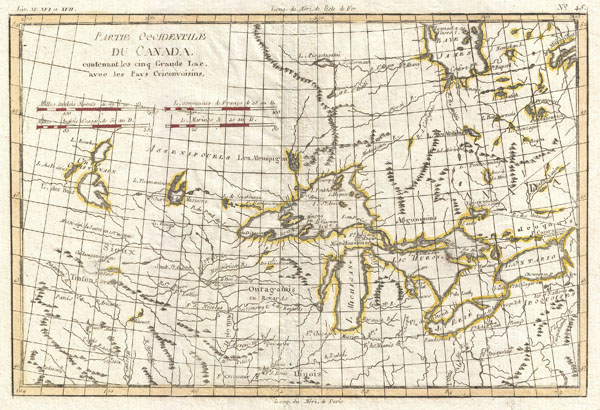An extremely attractive example of Rigobert Bonne's c. 1775 map of the Great Lakes and upper Mississippi Valley. A map of considerable importance, this map was constructed during a period of aggressive exploration into this region. The French and English in North America, jealous of Spain's access to the Pacific via Mexico and Central America, were actively seeking their own 'westward passage.' By this time notions of a Northwest Passage through the Arctic were largely dismissed. Instead merchants and explorers turned their eyes inland towards the great system of Lakes and Rivers that filled the North American interior. With no concept that the vast barrier of the Rocky Mountains stood in their way - the idea that a river route to the Pacific was not only reasonable, but a likely possibility. One of the more likely courses for this route is shown here - one can pass through the Great Lakes and, roughly following the current US-Canada border, pass upriver to Rainey Lake (L. Tecamamiouen)and then, through another River, to the Lake of the Woods (Lac des Bois), then, via another river, to (though it does not appear on this map) Lake Winnipeg. Here the water route westward ends - though at the time they didn't know it. Throughout this map, Bonne attempt to document rivers, mountains, forts, and American Indian tribes and villages with the most recent data obtainable. He identifies the lands of the Sioux, the Iroquois (Five Nations), the Algonquians, the Illinois, and many others. Chicago (Chicagou) and Detroit both appear as forts. The Great Lakes are mapped with a rough approximation of accuracy, though Lake Superior does include a number of apocryphal islands including I. Ponchartrain and I. Minong (also known as Phillipeaux). These islands first appeared Bellin's mapping of the region in 1750s and continued to appear until the 1820s. Drawn by R. Bonne and published in the 1780 edition of Atlas de Toutes les Parties Connues du Globe Terrestre...
Cartographer
Rigobert Bonne (October 6, 1727 - September 2, 1794) was one of the most important French cartographers of the late 18th century. Bonne was born in Ardennes à Raucourt, France. He taught himself mathematics and by eighteen was a working engineer. During the War of the Austrian Succession (1740 - 1748) he served as a military engineer at Berg-op-Zoom. It the subsequent years Bonne became one of the most respected masters of mathematics, physics, and geography in Paris. In 1773, Bonne succeeded Jacques-Nicolas Bellin as Royal Cartographer to France in the office of the Hydrographer at the Depôt de la Marine. Working in his official capacity, Bonne compiled some of the most detailed and accurate maps of the period - most on an equal-area projection known erroneously as the 'Bonne Projection.' Bonne's work represents an important step in the evolution of the cartographic ideology away from the decorative work of the 17th and early 18th century towards a more scientific and practical aesthetic. While mostly focusing on coastal regions, the work of Bonne is highly regarded for its detail, historical importance, and overall aesthetic appeal. Bonne died of edema in 1794, but his son Charles-Marie Rigobert Bonne continued to publish his work well after his death. More by this mapmaker...
Source
Bonne, R., Atlas de Toutes les Parties Connues du Globe Terrestre, 1780.
Very good condition. Minor verso repair near the word 'Sioux'.
Sellers, J. R. and Van Ee, P. M., Maps and Charts of North America and the West Indies 1750-1789, 173. Kershaw, K., Early Printed Maps of Canada, nos. 973-976.


